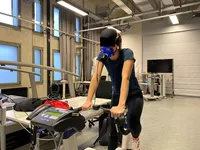Sensorimotor control & Motor learning
Studies of sensorimotor control in object manipulation, goal directed movements, postural control, navigation, motor learning and daily activities. Methods encompass kinematic (motion capture, accelerometry etc.) and dynamic approaches (hand- and finger forces, force plates etc.) as well as neuroimaging approaches such as functional magnetic resonance imaging (fMRI), transcranial magnetic stimulation (TMS) and lesion analysis.
Acute Effects of exercise on motor memory formation
Veit Kraft
Each of us learns new motor skills from early to old age. This can be our first steps, playing an instrument or a sporting movement. Various factors can influence how quickly we learn something and how well our brain consolidates such motor memories. For example, how these motor sequences are consolidated changes depending on the level of awareness. However, other factors influence how well we learn and consolidate motor memories, such as acute cardiovascular exercise, which arguably can have remarkably positive effects if it occurs shortly after motor learning and is highly intense. Therefore, we measure motor learning and the influence of acute cardiovascular stress on the consolidation of learned memory content. As a first step, this is done with young and healthy subjects. In a further step, we aim to investigate how such an exercise load affects participants of advanced age. In addition, we are interested in possible mechanisms that could potentially improve motor performance at the neuronal level, using transcranial magnetic stimulation to infer brain plasticity through corticospinal excitability.
Literature:
Cristini, J., Kraft, V. S., Heras, B. De, Rodrigues, L., & Parwanta, Z., Hermsdörfer, J., Steib, S. & Roig, M. (2023). Differential effects of acute cardiovascular exercise on explicit and implicit motor memory : The moderating effects of fitness level. Neurobiology of Learning and Memory, 205. doi.org/10.1016/j.nlm.2023.107846


Kinematic analyses of activities of daily living
Stephanie Schmidle, Philipp Gulde, Joachim Hermsdörfer
Sensorimotor impairments or decline of memory, orientation, and cognitive capacity due to neurological disease can severely impair the capability of patients and lead to dependency to care. In order to thoroughly assess complex activities of daily living (e.g., data filing, preparing tea) in subject with sensorimotor and cognitive impairments, for instance apraxia and action disorganization syndrome following stroke or dementia, we combine clinical established measures (questionnaires), qualitative (observation of behavior) and quantitative methods (eye-tracking to assess gaze behavior and motion-tracking to kinematically quantify behavior). Research with healthy controls and neurological patients provide valuable knowledge and data to classify individual movement behavior and strategy, predict clinical outcomes, and develop assistive devices and environments. In long-term, we hope to improve quality of life and support independency of patients, as well as to relieve caring relatives and the health care system.
Literature: Gulde et al., Exp Brain Res (in press), Gulde et al., Frontiers in Neurol (2018), Gulde & Hermsdörfer, Frontiers in Neurol (2018), Gulde & Hermsdörfer, Exp Brain Res (2017), Gulde et al., Frontiers in Hum Neurosci (2017), Bienkiewicz et al., Brain and Behavior (2015), Gulde et al., Eng Solutions in Neurorehabil Biosys & Biorob (2014)

Assessment of Fine Motor Deficits
Joachim Hermsdörfer
Skilled fine motor control is an essential prerequisite for many activities of daily living and professional life. Disturbances threaten independent and self-determined living. Fine motor deficits frequently result from neurological disorders such as stroke, infantile cerebral paresis, Parkinson’s disease and multiple sclerosis as well as from focal dystonia such as writer’s cramp. With our studies, we aim to identify aspects and factors characterizing fine motor deficits. We have merged our technological developments and our expertise from clinical studies to develop a test battery. Central component is an instrumented manipulandum (GF-Box) that records finger forces and object movements to analyze functional as well as more elementary aspects of object manipulation. Some clinical tests, for example to assess sensory perception, complete the test battery. Applying the test battery in stroke patients and controls, we were able to identify the three factors „fine motor force scaling“, „coordination“ and „speed“. Combination of these factors can explain 69% of the performance pattern of stroke patients in an everyday-like fine motor task. Present and future studies will test further populations, such as elderly persons, people with specific expertise or with neurological diseases.
Previous funding: Bayerische Forschungsstiftung
Literature: Allgöwer, K., Fürholzer, W., & Hermsdörfer, J. (2018), Allgöwer, K., & Hermsdörfer, J. (2017), Allgöwer, K., Kern, C., & Hermsdörfer, J. (2017)
www.tum.de/nc/die-tum/aktuelles/pressemitteilungen/detail/article/34176/
Predictive Mechanisms in Object Manipulation
Thomas Schneider, Joachim Hermsdörfer
Skilled object manipulation in everyday life is not possible without predictive consideration of the physical object properties into the planning of hand-object interaction. During grasping and lifting our finger forces have to adapt the weight and surface of the object and also must avoid object tilt, which for example would cause spillage of a lifted cup of coffee. To prevent tilt, we must predict the external torque and produce a counteracting torque already at the moment of lift-off. In our studies, we use a natural-like manipulandum, which allows overt and hidden variations of the center of gravity, to investigate finger forces and finger positions during predictive torque planning in healthy young and elderly persons as well as in patients with central nervous system diseases. We evaluate the influence of previous manipulations and of current geometric cues on the precision of torque planning. We also test the effect of different grip surfaces and the effect of ageing on the performance. In addition, we evaluate how motor planning influences the perception of object properties.
Literature: Schneider, T. & Hermsdörfer, J. (2016) Schneider, T., Buckingham, G. & Hermsdörfer, J. (2019)

